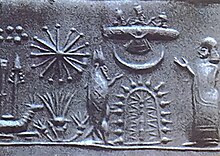Seven-dots glyph

The 7-dot glyphs (or globes) are first known in Mittanian art (Turkey, or ancient Anatolia),[1] but is possibly older. It appears in the iconography of cylinder seals, and later on reliefs, or other motifs. With origins on cylinder seals, its meanings may come from paleohistory back to the 4th millennium BC, or even further into the 6th to 5th millennium with the origins of Europe, or Turkey's Çatal Hüyük.[citation needed]
The 7-dot glyph was at first six dots surrounding a central dot; later two rows of 3-dots ended with a 7th as the finial.[1]
Later iconography of seven gods
Originally the seven dots probably related to the Sumerian Sebittu. Later gods included Seven (gods), the Seven, possibly referencing the Elamite god Narudu.[1]
For '7' being the first prime number after '5' (easily represented by the 5-fingered human hand, with šu–![]() . , as the cuneiform for the "hand"), and later associated with the Seven Sisters, or sometimes the constellation Pleiades, it became iconographic.[1]
. , as the cuneiform for the "hand"), and later associated with the Seven Sisters, or sometimes the constellation Pleiades, it became iconographic.[1]
In ancient Egypt, the idea of '7' was associated with a person's birth. At birth, the Seven Hathors determined the fates in an individual's life.[2]
References
- ^ a b c d Black & Green 1992, p. 162.
- ^ Mercatante & Bianchi 1998, pp. 153.
Bibliography
- Black, Jeremy; Green, Anthony (1992). Gods, Demons and Symbols of Ancient Mesopotamia, an Illustrated Dictionary (3rd printing 1997 ed.). Austin, TX: University of Texas Press. ISBN 978-0-292-70794-8.
- Mercatante, Anthony S.; Bianchi, Robert Steven (1998). Who's Who in Egyptian Mythology (2nd ed.). New York: Barnes and Noble Books. ISBN 0-7607-0898-3.


